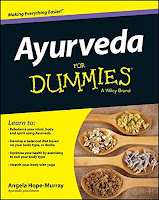Ayurveda For Dummies by Angela Hope Murray (2013)
, 04 September 2015
Ayurveda for Dummies is a basic approach to what Ayurveda holistic medicine is, its origins, principles, practices, beliefs, ways to incorporate it into your life, and traditional remedies.
I didn't know much about Ayurveda, beyond Ayurveda beauty and relaxing treatments, so it is great putting things into perspective to understand how a whole continent and culture approaches health, wellness, disease and healing.
Put it simply, Ayurveda is an alternative and millenarian medicine system born and widely practised in India, but with many devotees and practitioners all over the world. Many of the practices are common-sense ways of taking care of your body mixed with traditional herbology and Eastern philosophy and beliefs.The originality of Aryuveda resides in its integrative philosophy, in which body, mind, soul and energy are all interrelated and presented in your body; a system in which your lifestyle, diet, exercise, and spiritual practices are extremely important and clearly related. Yoga is an integral part of the system as well as herbal remedies. Also characteristic of Ayurveda is the classification of human beings into three basic doshas or types (these doshas have common traits regarding their physical constitution, temperament, psychology, levels of energy and ways in which the body reacts to food and healing). Aryuveda considers sickness an expression of lack of balance in the body. Aryuveda, as Western Medicine, has different branches and specialities.
The Ayurvedic mode of living aims to maximise your lifespan by optimising your health through interventions that care for your body, mind, spirit and environment. Ayurveda places a great emphasis on the prevention of disease and on health promotion, as well as on a comprehensive approach to treatment. (...) Ayurveda places great emphasis on the effects of the different seasons and your diet on the equilibrium of the body (...) Ayurveda recognises the importance of the environment to your health (...) addresses eating the best food to improve your immune system. (Locations 453-455, 484-485, 489-490 and 495)Isn't that the aim of Western Medicine and dietetics? Ayurveda reminds me immensely of pre-modern Western Medicine, the one in which body and soul, mind and body were tightly linked, a Medicine based in the four temperaments-humours-elements minus the Yoga and the chakras.
However, I want to mention two things that caught my attention and I find utterly intriguing and specific to Ayurveda. The first is that Ayurveda cannot be separated from the Sanskrit word:
The complexity of Sanskrit in its level of sophistication and scientific accuracy is only mirrored by mathematics. The process of perfecting the language has taken thousands of years. In the past, Sanskrit was the language used by all the sciences, which were all orientated towards the study of the self in all its aspects. The use of the language itself is an instrument for healing. Its beautiful resonances, which you can experience without even having to understand the meaning, can reach the very core of your being. All languages vibrate the being, but Sanskrit somehow enables you to keep currents of energy flowing so that you can enter into and maintain an inner harmony. I’ve used the Sanskrit terms for this reason throughout the book. (Kindle Locations 522-527).
Commentators of Ayurveda, tells us that ‘Each individual is the unique expression of a recognisable finely tuned cosmic process occurring in space and time.’ (...) Because you are formed of the same substance as the creation, you are truly a microcosm of the universe.(Kindle Locations 575-580)Explaining some of the concepts in Ayurveda is not easy, but Murry does a great job at introducing those concept for us, adding very useful explanatory tables and illustrations, and providing us with Western medicine terminology to match the one found in Ayurveda.
I am a fan of tables, Anything can be explained, clarified and organised in them. This being the case, I really like the many tables in this book, which are really helpful. They are great to discover what your dosha is, the best foods, exercises and medical approaches for every dosha, the characteristics of chakras and so on. The illustrations are also very helpful and simple to understand.
Many items of advice in the book can easily be incorporated into your daily routines if you feel like, even if you don't want to follow Ayurveda. Murray is keen to provide readers with simple remedies to be incorporated into our lifestyle, some of them might be for you while others might not.
I found very useful the glossary of Sanskrit words and the botanical glossary with equivalences between Sanskrit, Latin, Hindi and English names. If you are really into Ayurveda, the final appendix contains a list of links to suppliers of herbs, journals, organisations and institutes of Ayurvedic education that will come handy.
Murray takes literally that she is writing for dummies and some of the writing is overly simplistic, repetitive, bloggish, and some of the content in the book a series of truisms that apply to the way of understanding well-being by your grandma or you if you have a minimum dose of common sense and are keen on keeping healthy.
A huge amount of space is devoted to the description of some basic Yoga exercises. If I wanted a book on Yoga I would have bought another one. I
understand that this an integral part of Ayurveda, but describing an
exercise is nothing I enjoy or find useful, even if it is accompanied by illustrations. Perhaps a link to videos with the exercises would have been more useful (to me). This is the 21st century after all.
The formatting
has too many headings and too large (some of them occupy the space of
four lines, see photo), and to me this always feels as a naughty way of filling
pages, not a way or making the headings and subheadings clearly
visible. 
















